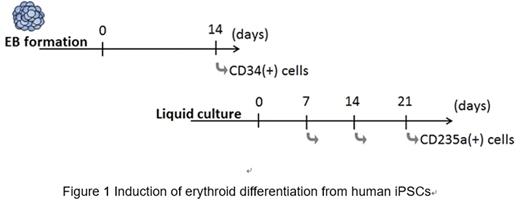Abstract
The congenital dyserythropoietic anemias (CDAs) are congenital red blood cell disorders representing ineffective erythropoiesis and dyserythropoietic changes in the bone marrow. We diagnosed a female patient with undiagnosed congenital anemia as type IV CDA caused by a heterozygous missense mutation of the erythroid-specific transcription factor, KLF1; c.973G>A, p. E325K. Although the mutation has been reported in a male patient characterized as hydrops fetalis, severe neonatal jaundice and transfusion-dependent anemia (Arnaud L et al., Am J Hum Genet, 2010), the proband showed relatively mild phenotype showing moderate dyserythropoietic anemia. In order to investigate the pathological significance of mutant KLF1 during erythropoiesis, we generated induced pluripotent stem cells (iPSCs) from peripheral blood of the CDA patient (CDA-iPSCs), and utilized these cells for better understanding of its molecular basis.
Hematopoietic precursors were induced from CDA-iPSCs by embryoid bodies formation. CD34(+) precursor cells were then isolated and cultured in the presence of cytokine cocktail for additional 1-3 weeks (Figure 1). Morphological analysis revealed that many erythroblastic cells derived from CDA-iPSCs were multinucleated, in accordance with that of bone marrow erythroblasts from CDA patient. Flow cytometric analysis showed that CDA-iPSC-derived cells contained significantly lower percentage of CD235a(+)/CD71(+) erythroid lineage cells than the cells derived from control iPSCs. CD71 expression decreased in time during erythroid differentiation culture in control CD235a(+) cells, whereas it maintained in CDA-iPSC-derived cells, indicating inappropriate maturation of erythroblastic cells.
These data promoted us to explore the possibility of cell death in CDA-iPSC-derived cells during erythroid differentiation culture by comprehensive microarray analysis of erythroblastic cells. In CDA-iPSC-derived cells, many positive and negative regulators of cell-cycle, such as E2F2 and CDKN2C, were differentially expressed, indicating the disruption of cell-cycle control during late stage of erythropoiesis from CDA-iPSCs. In consistent with this, significantly lower percentage of BrdU-uptaking cells were detected in CD235a(+) cells derived from CDA-iPSCs after 3 hour pulse of BrdU during erythroid liquid culture.
Most of the KLF1 mutations with functional alterations currently reported are classified into hypomorphic variants or truncating loss-of-function variants. KLF1 E325K has been reported to actively interfere with transcription of KLF1 target genes (Arnaud et al., 2010). Our findings suggest that KLF1 E325K variant might act to disrupt the transcriptional control of various cell cycle regulators including known KLF1 target genes E2F2 and CDKN2C, which lead to the pathological cell-cycle arrest in type IV CDA patients. Our model provides insights on understanding the mechanisms of type IV CDA, and it would be a useful tool for drug screening and identification of novel biomarkers.
Kohara: neo ALA CO.,LTD.: Research Funding. Sugawara: neo ALA CO.,LTD.: Research Funding. Yoshie: neo ALA CO.,LTD.: Research Funding. Tani: neo ALA CO.,LTD.: Research Funding; SHINNIHON PHARMACEUTICAL CO., LTD: Research Funding.
Author notes
Asterisk with author names denotes non-ASH members.


This feature is available to Subscribers Only
Sign In or Create an Account Close Modal